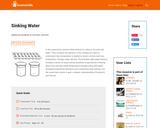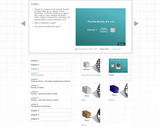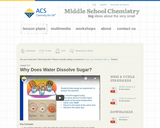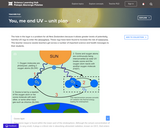
This video describes and demonstrates the different structures, states, and properties of matter, including demonstrations conducting in space.
- Subject:
- Science
- Material Type:
- Demonstration
- Provider:
- European Space Agency
- Date Added:
- 04/20/2018

This video describes and demonstrates the different structures, states, and properties of matter, including demonstrations conducting in space.

Students learn the relative sizes and order of the planets while making a scale model of the solar system using common food items. They will calculate weights and/or gravity on planetary surfaces. They will calculate the densities of planets and learn how density relates to a planet's composition.

This worksheet assesses student understanding of physical properties of matter.

This activity will set up a series of experiments that will help students identify and find physical properties of water. A discussion of what the students know (or believe they know about water) will start this activity. Once the properties are discussed, methods of testing these properties will be discussed by the instructor, leading the students into the students' development of these labs.

In this lesson, students will plan and carry out an experiment which tests the densities of 5 different water sample. After successfully completing the experiment, students will have five colors of water stacked in a straw and understand the relationship between salinity and density.

This course was created by the Rethink Education Content Development Team. This course is aligned to the NC Standards for 6th Grade Science.

This course was created by the Rethink Education Content Development Team. This course is aligned to the NC Standards for 6th Grade Science.

This course was created by the Rethink Education Content Development Team and is aligned to the NC Standards for 6th Grade Science.

In this project-based activity, students will make a model phytoplankton or zooplankton organism which will sink slowly. They will use their knowledge of density to design an organism that is just barely heavier than water.

In this experiment, learners float colored ice cubes in hot and cold water. They compare the behavior of the melting ice cubes to understand how temperature is related to ocean currents and how temperature changes water density. The printable eight-page handout includes a series of inquiry-based questions to get learners thinking about how and why water temperature changes along with depth. Illustrated experiment directions and a worksheet help learners use the experiment results to gain a deeper understanding of buoyancy and density.

Students create a density column using four different colored layers of sugar water. Students will choose varying amounts of sugar to add for each solution.

Students will observe a solubility test between salt and sugar. They will then be presented with 4 known crystals and an unknown. Based on the solubility demonstration, the class will design a solubility test to discover the identity of the unknown.

In this activity, students put cotton balls, crushed paper, and sand in boxes with different sizes to explore the relationship between mass, volume, and density.

This resource is an animation that summarizes the process for finding the density of a solid cube. It accompanies the lesson plan, "What is Density?"

Students will be able to explain, on the molecular level, how the polar characteristic of water and sugar interact so that water dissolves sugar.

This resource is an animation that accompanies the lesson, "Why Does Water Dissolve Sugar?"

With an often unexpected outcome from a simple experiment, students can discover the factors that cause and influence thermohaline circulation in our oceans. In two 45 minute class periods, students complete activities where they observe the melting of ice cubes in saltwater and freshwater, using basic materials: clear plastic cups, ice cubes, water, salt, food coloring, and thermometers.

In this lesson, students will measure the dimensions of various wood samples, then calculate volume, mass, and density for each sample.

Students examine the electromagnetic spectrum and the different wave types that make it up,
look at positive and negative points of UV radiation, use UV beads to investigate UV intensity, and investigate how sunscreen use can decrease the negative impact of overexposure to the harmful rays of the sun.